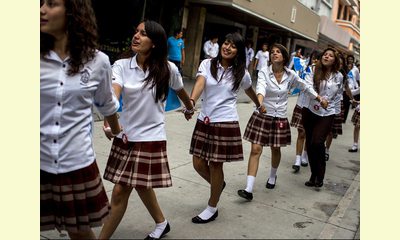|
|
Youth call for peace and an end to violence in the streets of Guatemala
un articulo por RPP International/EFE
Hundreds of Guatemalan youth, college students and
civic organizations commemorated the International
Day of Peace with a call to end violence in the
country, where there are more than 6,000 murders
each year. In the Paseo de la Sexta, in the
historic center of the capital, young people
formed a human chain in front of the National
Palace of Culture to demand a culture of peace.

Congregated in the historical center of Guatemala City, the youth form a human chain to demand a culture of peace and non-violence
click on photo to enlarge
Pedro Cruz, leader of the Youth Association of
Guatemala, told EFE that this is the first time the
capital has seen a human chain to demand peace and
end violence.
Almost 50% of the crimes that occur each year in
Guatemala are by young people between 12 and 29
years old, according to official statistics. Over
80% of murders in this Central American country are
committed with firearms.
"Constructing a culture of peace is a task for
everyone", "no more assaults" and "Guatemala needs
peace" were some of the legends that were read on
T-shirts worn by the youth, who also painted on
their foreheads and cheeks the words peace and
"24-0" in reference to 24 hours with zero
homicides.
Cruz said a white rose was transferred from hand
to hand among the youth who participated in the
human chain from the Municipality to the former
Presidential Palace, where a monument stands to
mark the 1996 Peace Accords that put anend to the
36-year armed conflict that left 200,000 victims,
dead or missing.
The objective of this symbolic activity, organized
by some 14 civil society organizations, is to seek a
transformation of Guatemala, in the framework of the
International Day of Peace that was declared in 2001
by the General Assembly of the United Nations.
Cruz said that besides the human chain today,
there will be a concert next Sunday with the theme
"Make music and not violence" in the Mateo Flores
stadium in the capital. The concert, which is
organized by the government, businessmen, artists,
sportsmen and civil society, seeks to raise
awareness among young people about the scourge of
violence. The event, also called "24-0", is a
replica of the concert held in October 2011 by the
Colombian musician Cesar Lopez, in order to create
awareness in the society to change the climate of
insecurity.
On that day it is expected that the authorities
will destroy more than 19,000 firearms that have
been seized by police.
Artists such as the Nicaraguan Luis Enrique, the
Panamanian Joey Montana and the Guatemalans Cesar
Lopez, and Clover Shop Winches, among others, will
take part in the concert that promotes peace in
the Central American country.
(Click here for a Spanish version of this article)
|








|
DISCUSSION
Pregunta(s) relacionada(s) al artículo :
Is there a renewed movement of solidarity by the new generation?,
* * * * *
Comentario más reciente:
from Javier Collado Ruano, Director of Edition at Global Education Magazine, on the occasion of the International Day of Solidarity.
Solidarity is a trans-dimensional phenomenon that goes beyond the ontological essence of human nature. In fact, when we analyze the connections between the microcosm and the macrocosm, we perceive that human beings are not involved in chaos and arbitrariness, but belongs to the large network of interdependencies, complementarities and reciprocities that constitute life. The emergence of life on Earth, around 3,8 billion years ago, was a complex process of exceptional natural phenomena, inherent in all living systems. A process which is expressed through unlimited creativity: mutation, gene exchange, and symbiosis. From a cosmo-biological perspective, we can understand a new conceptual dimension of life, where all living beings share same basis of genetic code: the twenty amino-acids and four phosphatic bases. In fact, the diversity of living beings is caused by the combination of this cosmo-bio-genetic basis.
This trans-dimensional perspective has a deep ecological and spiritual sense for our worldview because the human evolutionary adventure is the latest stage of life on Earth. The modern human being is a vertebrate animal, mammal, belonging to the primates, which emerged 200,000 years ago. In recent centuries he has imposed its anthropocentric, industrial and capitalist vision to the detriment of Pachamama (and Indigenous goddess known as earth mother). We consume around 120% of the natural resources that Earth Mother regenerats annually. Our consumer behavior is immersed in a fatalistic dynamic with a destiny to climate change (deforestation, loss of biodiversity, ozone, etc.), and our own self-destruction as a species.
There is an urgent need to get beyond the cognitive fallacy that the mental structures of social Darwinism and capitalist postulates of the 19th century have historically constituted, because they only understand natural and social systems as warmongers and competitive processes whereby species diverge from each other. . ... continuación.

|
|









